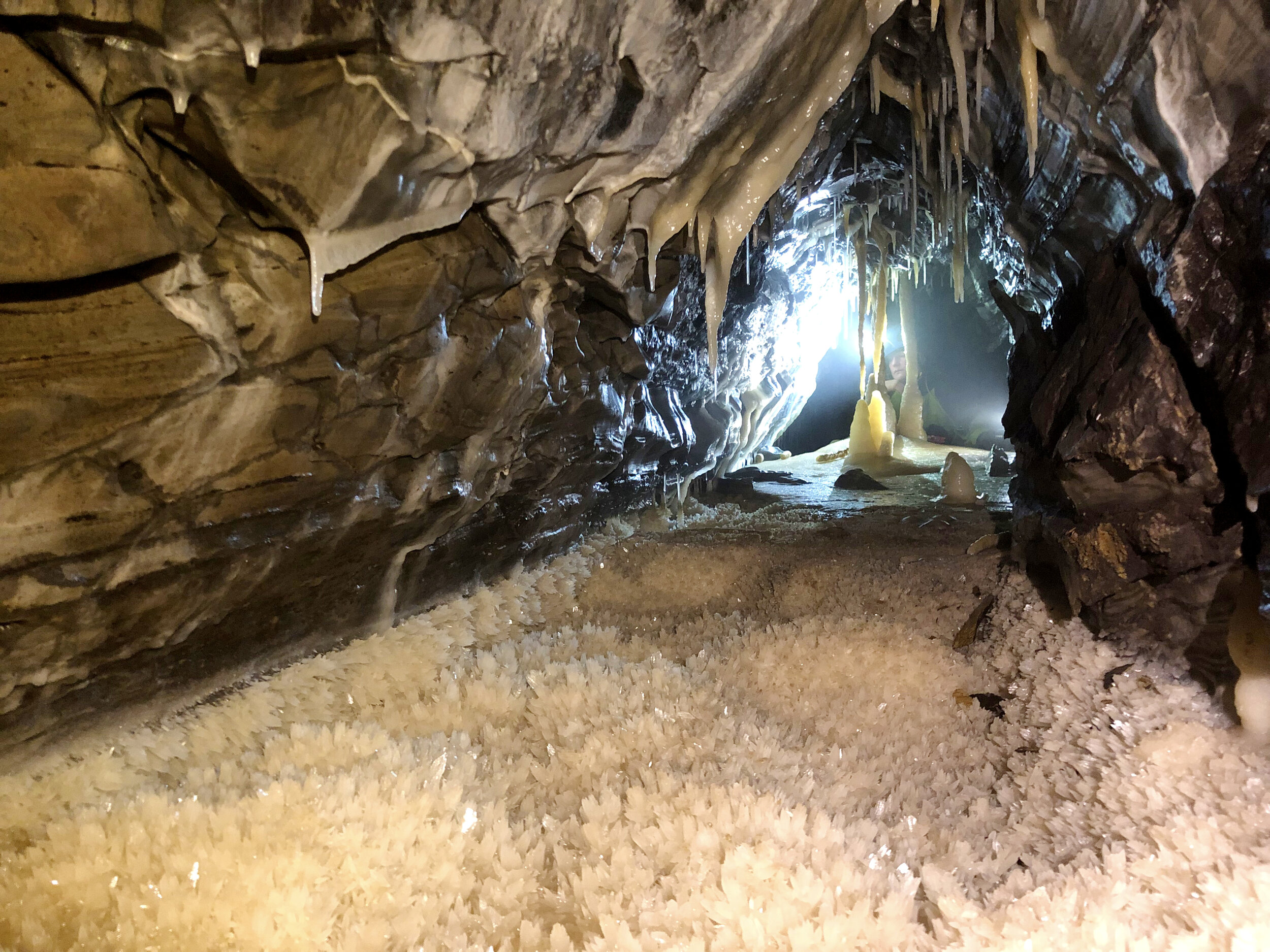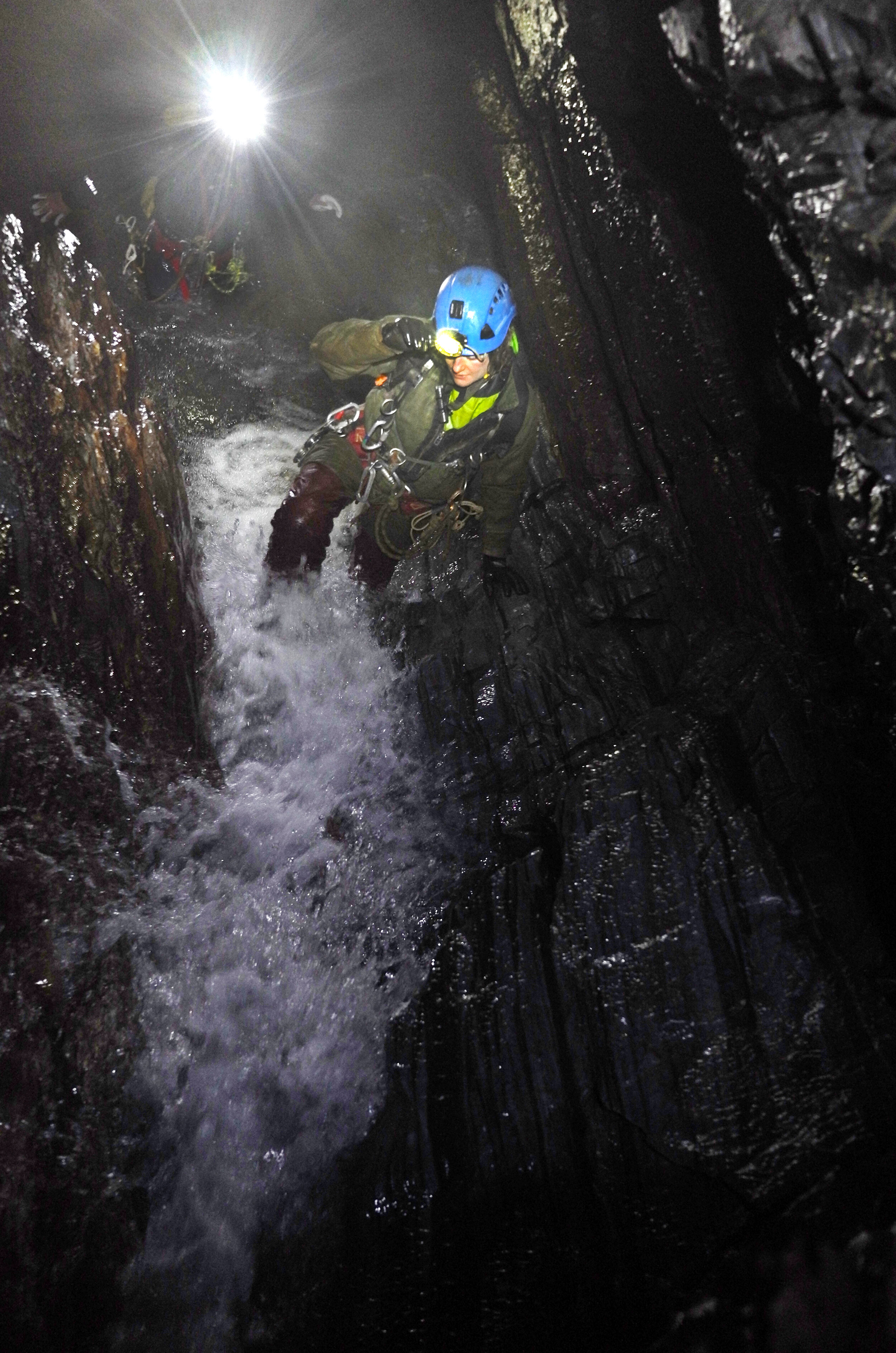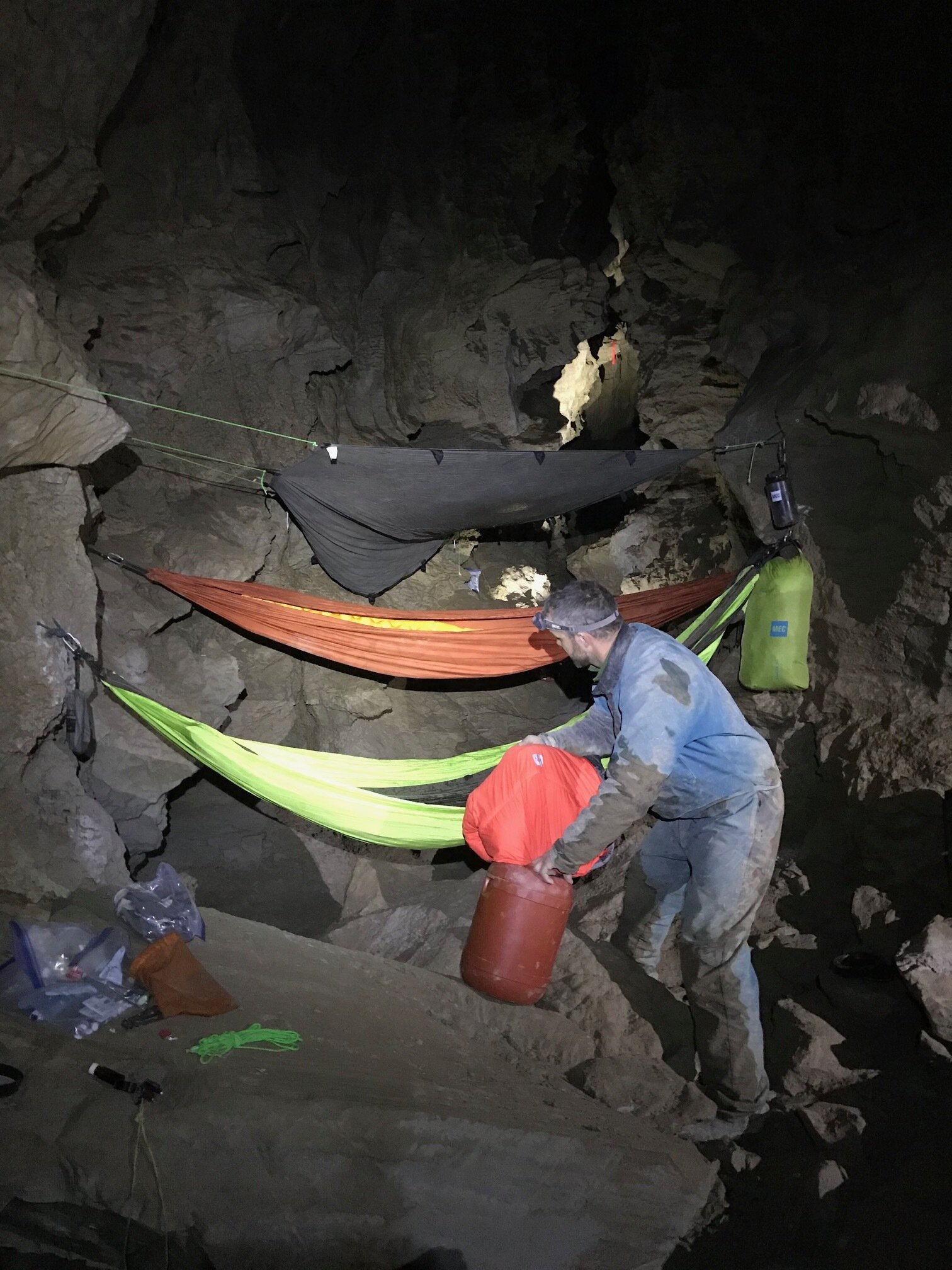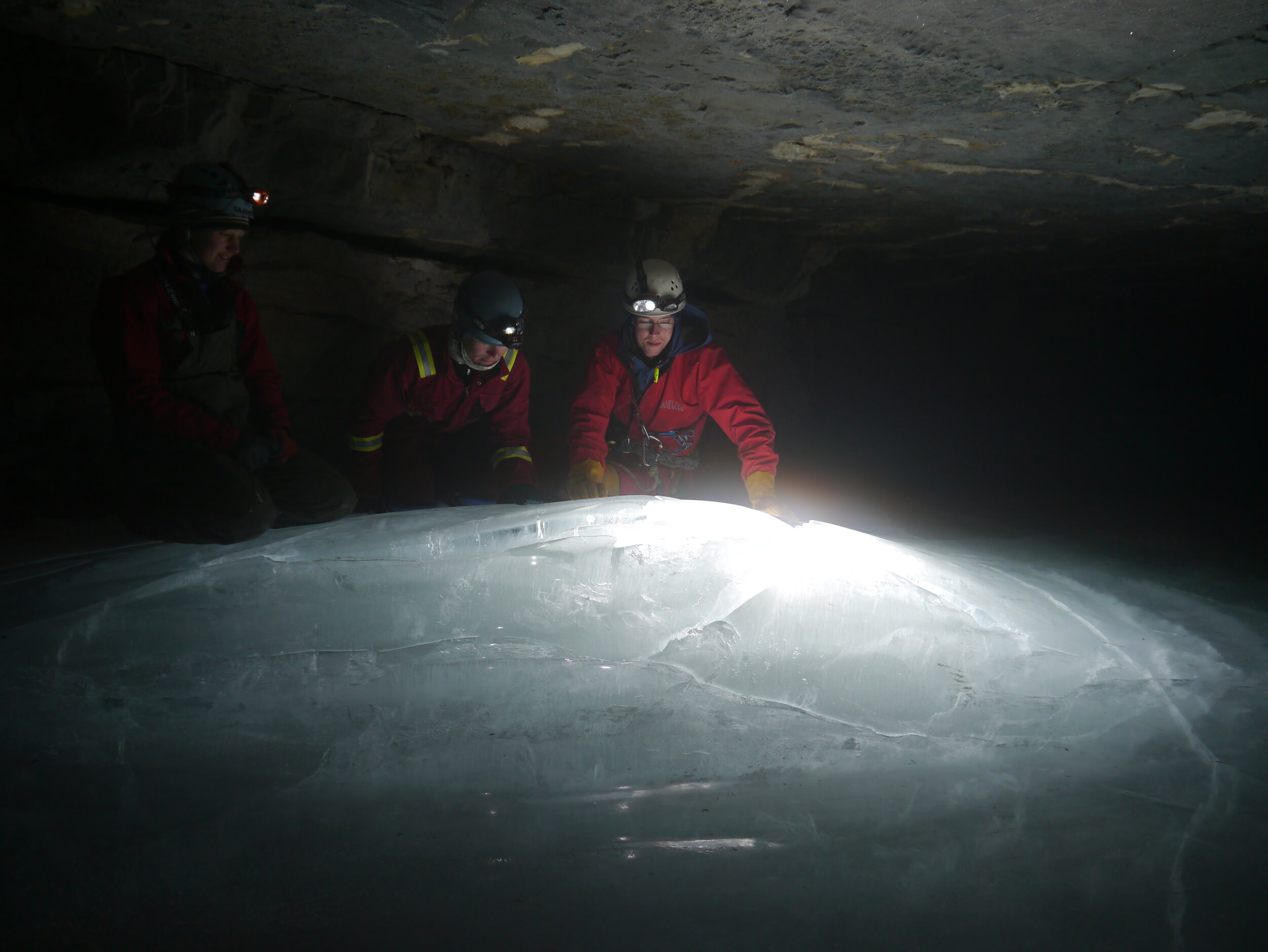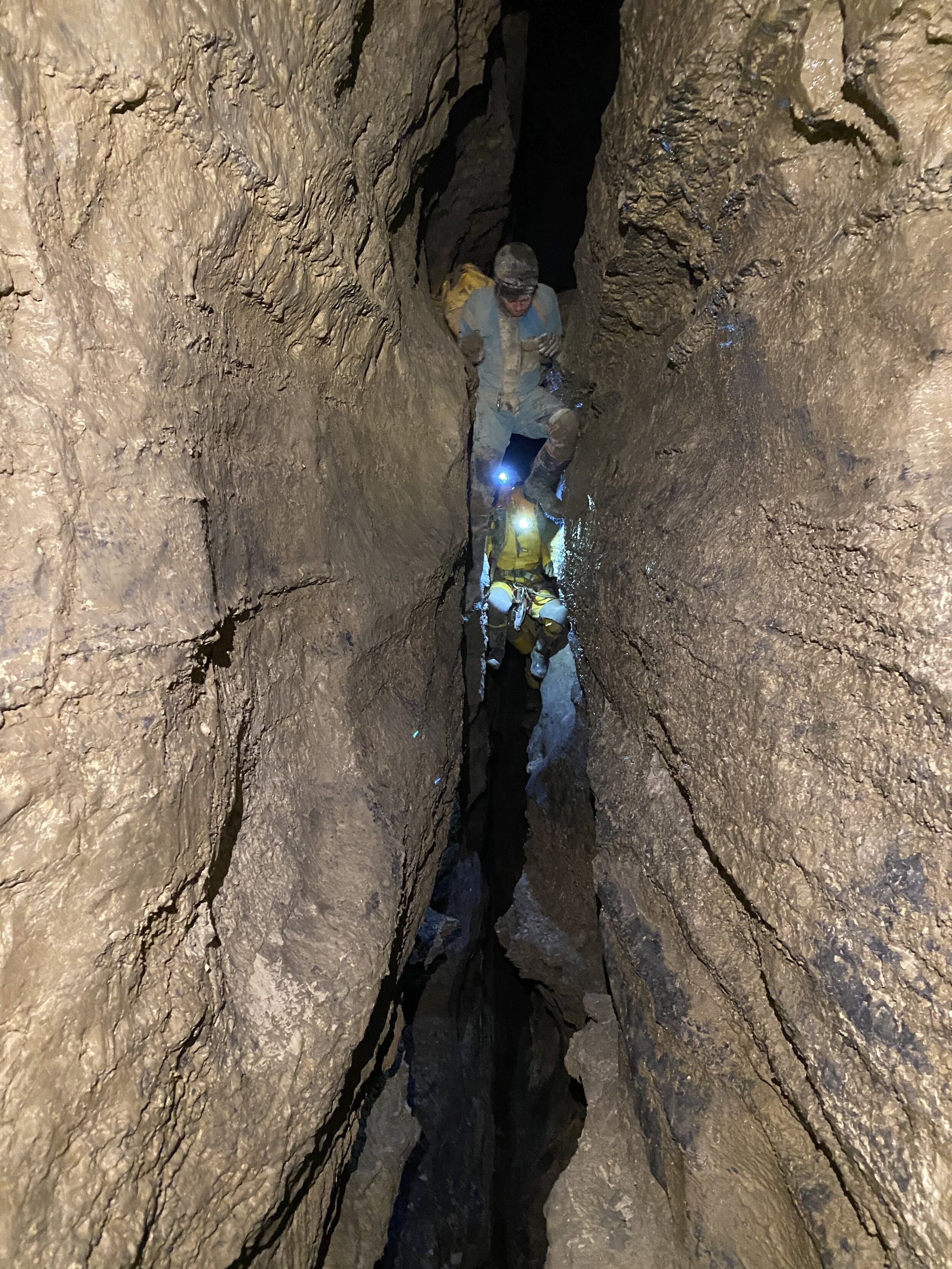Dark Frontiers: Exploring Western Canada’s Underground
Modern mountaineers can view mountains and routes in broad daylight, but cave exploration remains a journey into unknown territory. The underground is hidden, and even finding a cave can be a challenge. Searching for new cave systems may require as much effort as exploring them. The western mountain ranges and forests abound with shallow cave entrances and sink holes, but most of these features are plugged with frost-shattered rock and till, and don’t “go.” It may require years of work to find a route into the “main drain.”
The Crystal Tube, Raspberry Rising. Photo: C. Stenner 2018
Once a major cave is found, multiple exploratory trips determine the ultimate depth or length of the passages. Western caves require technical climbing ability – from the top down – as well as specialized exposure gear to deal with the low temperatures. There is also a firm ethic to survey new discoveries and publish maps. Invariably a major cave will expand gradually as each expedition pushes further into new territory. Exploration of some caves – such as the twenty-one-kilometre-long Castleguard Cave – continues after fifty years.
While caving for sport remains a popular pastime in the 1,800 +/- catalogued western caves, Canada has a small and dedicated cadre of “project cavers” dedicated to exploration. This tradition dates to 1965, when Dr. Derek Ford’s geography students at McMaster University began to explore the karst of the NWT, BC, and Alberta.[1] Ford’s team triggered a “golden age of discovery” that continues today. Since then, a handful of caving organizations have formed, and the carbide lamps and cotton coveralls of the 1960s have been replaced with modern exposure suits and high-output headlights. Yet the conditions underground remain unchanged; they range from the uncomfortable to the appalling, with flooded passages, exposed climbs, loose rock, and constrictions. And invariably, the caves get deeper, longer and more difficult.
Recent Discoveries and Records
The pace of discovery has picked up in the last decade. Highlights include Bisaro Anima, currently the deepest cave in Canada at 674 metres, with a depth potential of 900 metres. Discovered in 2012, the cave is amongst fourteen caves and over 150 sinkholes and entrances found on the Bisaro Plateau in southeastern BC.[2] The multi-year project continues with a current length of 6,599 meters, now the seventh longest cave in Canada.[3] Bisaro is notable for its mid-winter, underground camps of up to 8 days duration, and the use of cave diving to push its lower flooded passages.
The great unnamed river cave (people circled) on Upper Ovis Creek, Wells Gray Provincial Park. Photo: J. Pollack 2018
Within Glacier National Park, BC, Raspberry Rising is the longest marble cave in Canada, recently explored to 5,504 metres in length and 219 metres depth. The cave contains incredibly diverse and unique cave formations making it the most decorated example in the country.[4] Unlike most caves that are formed in limestone, Raspberry Rising’s folded marble “stripe karst” has sparked the wider exploration of marble outcrops in the Rockies. Exploration of another “stripe karst” cave – White Rabbit – began in 2009, and currently it has 5,350 metres of passages 459-metres deep. The latter cave may connect to other, adjacent caves, with depth potentials of 600-840 metres.[5]
In 2019, a connection was made between two large caves – the Arch/Treasure system (12,080 metres) and Resonance Cave (4,596 metres) – on Vancouver Island via a twenty-six-metre dig through a sediment-filled passage. The resulting system is now the second longest in Canada at 17,101 metres in length and 400 metres in depth.[6]
An unexpected 2018 find in Wells Gray Provincial Park was a large vertical shaft located during a helicopter caribou survey. An immense 102 x 60-metre pit has formed in marble, swallows a small river, and is one of the largest cave entrances in Canada. The huge passage was explored to a depth of eighty metres, and it continues downward from there, promising perhaps the most spectacular river caving yet seen in Canada.[7]
A Cave Diving Renaissance
Water often fills cave passages and halts exploration – temporarily. Modern Canadian cave diving with open-circuit SCUBA began in the mid-1980s on northern Vancouver Island and in Canada’s longest underwater cave, the 6,563-metre Three Island Cave (Ottawa River, Ontario). The introduction of closed-circuit rebreathers revolutionized this extreme exploration method, and significantly increased the range of trained cave divers. The downside of cave diving is large loads of gear, particularly in remote alpine locations. In 2018, one team took more than a week to undertake a short solo dive by Kathleen Graham at the bottom of Bisaro Anima, which established the cave as Canada’s deepest.[8]
Unquestionably, the most significant cave diving effort was made by Martin Groves, who, in 2009-2010, pushed Boon’s Blunder in Castleguard Cave for 885 metres to reach a large, continuing air-filled passage. The breakthrough promises a major extension in Canada’s longest cave, but efforts to return have been stymied by ice blockages in the low crawls near the cave entrance.[9]
Cave diver in Wet Dream Cave, northern Vancouver Island. Photo: E. Wolpin 2018
Other examples include the spectacular find Wet Dream, a 1,710-metre-long underwater cave on northern Vancouver Island. This system was first dived in 2012 and mapped between 2015-17.[10] It lies in the same region as Reappearing River, a large 1,604-metre underground river system that had been pushed hard in 1990 by open-circuit cave divers, and extended by a large team in 2019 to a depth of seventy-seven metres.[11]
A notable 2018 effort, by Jason Richards, was Canada’s deepest cave dive at Hole in the Wall Cave NW of Tumbler Ridge, BC, where he reached ninety-four metres in a short, steeply-descending passage.[12]
Cave Science
Cave exploration is commonly allied with science, notably karst geomorphology, cave biology, and paleontological research. The late Chas Yonge, an early collaborator on this essay, pioneered the measurement of fluid inclusions in speleothems (cave formations),[13] methods that have formed the basis for modern cave paleoclimate research. Recent data from speleothems collected from Grotte Valerie in the NWT show a record going back 1.4 million years.[14] Ice caves (caves in rock which contain perennial ice) are sensitive indicators of present-day climatic conditions, as well as archives of past climates. Recent observations have shown that that ice caves in northwestern Canada are losing their perennial ice accumulations at an accelerated rate.[15] Other impacts are also being observed. The ice loss from glaciers and snowfields exposes new terrain, and is responsible for the Wells Gray find. And after nearly fifty years of relative stability, surface meltwater percolating underground and then freezing has made Castleguard Cave, Canada’s most famous and longest, inaccessible several times in the last decade.[16] There are other remarkable collaborations resulting from cave exploration. Recently unique extremophile bacteria, with potential as novel treatments against multi-drug resistant infections, have been found in western Canadian caves.[17] Also, dedicated bat biologists have teamed up with cavers to seek solutions for White Nose Syndrome, a disease that has devastated eastern bat populations.[18]
The exploration of Canada’s western caves remains a tough and rewarding game pursued by specialized explorers, and it is adding to our knowledge of our geography, climate, and biology. This article mentions a few of the more prominent projects, and there are many others. Canadian cave exploration has carried across three generations, and more discoveries are likely. It is entirely possible that the golden age of discovery will continue for another fifty years.
Author bios
John Pollack is a retired BC government forest scientist, serves on the Board of Governors for the Royal Canadian Canadian Geographical Society, and is a Research Associate with the Institute of Nautical Archaeology. He has been involved in international and Canadian caving for more than 5 decades.
Christian Stenner has been a caver for sixteen years, completing expeditions in North America as a member of the Alberta Speleological Society. He is a Fellow of the Royal Canadian Geographical Society and a Fellow International of the Explorers Club. He also serves as Alberta provincial coordinator for the Alberta/British Columbia Cave Rescue Service.
Dr. Charles (Chas) Yonge was a legendary Canadian rock climber and creator of bold routes, a strong expeditionary caver, cave scientist and author, who passed away this February during the writing of this essay.
References
[1] Thompson, P. (Ed.). Cave exploration in Canada. A special edition of The Canadian Caver Magazine (1976).
[2] Stenner, C., Bruns, J. & Graham, K. The Bisaro Caves Project 2018 Expeditions: Final Report to the Royal Canadian Geographical Society (2019); Bruns, J., Stenner, C., & Stenner, M. Dye trace shows depth potential of Bisaro Anima. The Canadian Caver Vol. 85: 4-6 (2018).
[3] Stenner, C. New insights from Canada’s deepest cave, Bisaro Anima. Canadian Geographic. https://www.canadiangeographic.ca/article/new-insights-canadas-deepest-cave-bisaro-anima (24 Jan 2020).
[4] Graham, K. & Stenner, C. Tupper Cave System Report 2018. Final report to Parks Canada. (July 2019).
[5] Hickson, C., Pollack, J., Struik, L., Hollis, L., & Yonge, C. Discovery of a significant cave entrance in stripe karst, Wells Gray Provincial Park, BC, Canada. Can. Jour. Earth Sciences (in press).
[6] Countess, R., ARGO Cave System. The Canadian Caver Vol. 88 (in press).
[7] Hickson, C. et al. Discovery of a significant cave entrance in stripe karst (in press).
8] Stenner, C. et al. The Bisaro Caves Project 2017 Expedition (2018).
[9] Stenner, C. Castleguard Cave expedition. Alpine Karst Vol. 4:40-49. (December 2012).
[10] Norris, P. Wet Dream: diving beneath a Vancouver Island riverbed. The Canadian Caver Vol. 77:26-29 (2012); Norris, P. Wet Dream Cave. The Canadian Caver Vol. 84:21-23 (2017).
[11] Jack, R. 2019. Reappearing River – a tale of two caves. The BC Caver, 33-3:9-17 (2019).
[12] Norris, P. 2018. Just another Hole in the Wall. The Canadian Caver Vol. 85:30-31 (2018).
[13] Yonge, C.J. Stable isotope studies of water extracted from speleothems. (Doctoral thesis). (1982).
[14] Horne, G. Personal communication. (February 2020).
[15] Yonge, C.J., The fate of ice caves in northwest Canada as climate warms: what will we lose? Final report to the Royal Canadian Geographical Society (2015).
[16] Horne, G., Graham, K., & Critchley, D., Use of time lapse photography to monitor seasonal ice formation in Castleguard Cave, Alberta, Canada. Proceedings of the 23rd National Cave and Karst Management Symposium (2020) (in press).
[17] Stenner, C. Return to Raspberry Rising. Canadian Geographic https://www.canadiangeographic.ca/article/return-raspberry-rising (5 Sep 2019).
[18] Davis, M. The BatCaver program. The Canadian Caver Vol 81:25-28 (2016).

